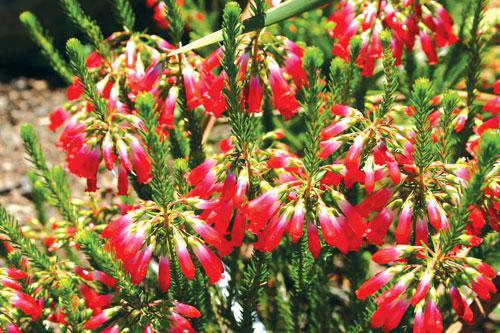E is for ericas and eucalypts – Phuket Gardening

PHUKET: There are plenty of plants which names begin with the letter “E” but none that can rival the 2,000 strong euphorbia family. So large is the genus that that one unheralded member completely slipped through the net last week.
Naturalized here, E. cotonifolia bears absolutely no resemblance to the exotic crown of thorns, or even to the brilliant yellow spurges of cooler climes. Instead, it has conventional reddish leaves which can become a brilliant crimson in the right conditions, namely, in full sun.
Slender-stemmed and multi-branched from the base, it will tolerate poor soils and even shade, though in such conditions the foliage will remain a dull greenish purple. An ideal plant for bare spaces where little else will grow. One of the first plants to colonize waste land, it is a real toughie and easily propagated from cuttings.
Some ericas or heathers are also pressed into service as border or bedding plants. Most varieties such as carnea or alpine heath, ciliaris or Dorset heath and cinerea or bell heather are generally found growing wild on temperate heathland, providing impenetrable cover for ground-loving birds such as grouse.
Often replaced here as a dense low growing border or rockery plant by easier to grow cuphea or false heather, there are nonetheless South African or Australian natives which will thrive in Phuket.
For example, E. densifolia, an unusual South African variety, has tiny green leaves and spikes of tubular red flowers whereas E. australis which actually, hails from Spain and Portugal, has an upright, spire-like habit and can reach three meters in height. Most ericas are characterized by tiny narrow leaves and pink, white or red tubular flowers; almost all require an acid, peaty or neutral soil.
Altogether more tropical in appearance is the torch ginger or etlingera. For a long time, I marveled at these heavy cone-like red blooms atop thick ram-rod straight stems which appeared as cut flowers in local markets. They look even more impressive in their natural surroundings, extravagant clumps, up to twenty feet across, of huge pointed dark green leaves and fleshy 4-5 foot stalks rising straight from the ground and bearing these cone-like, flaming, waxy inflorescences.
If any plant epitomizes the tropics, this is surely it. Unsurprisingly, its native habitat is the jungles of Malaysia and Indonesia where it thrives on the humus-rich moist soil of the rainforest. If you want to grow etlingera , remember that it will, like all gingers, need organic soil, protection from wind and time to spare. Oh and plenty of space!
I suppose we should allow the eucalyptus a modicum of space. That, unfortunately, is the trouble. Give this tree an inch and it will take a yard. There is a large colony, fully fifty meters tall, of what Australians call “gum trees” at the end of my soi. I can’t imagine they were put there deliberately, since this clump has never been harvested as timber [the trees are notoriously fast growing], though they are planted in Mediterranean climates as roadside trees to provide shade.
Perhaps some public-spirited Thai did just that. But they are a mixed blessing, for though the saplings are pressed into service here for scaffolding, the mature trees syphon up vast quantities of water. In Southern Spain, they have begun to remove them for this very reason.
Eucalypts are nonetheless interesting. The juvenile leaves are often different from the adult ones, broader and more attractive than their seniors. The wood is rich in fragrant oil and the flowers are replete with nectar and include some of the world’s finest honey plants.
Perhaps we should try more of the interesting ornamental varieties in Thailand: for example, E. alba which has beautiful smooth white bark, E. blakelyi which has ornamenta l value with showy clusters of whitish flowers, or E. cicerea or cordata, both of which possess silvery-gray foliage. There are 700 species to choose from and they will all grow here. Spoiled for choice.
Tip of the week – Pollination of your plants
You may have shrubs or trees which are not yielding fruit. There may be many reasons for this lack. All conventional plants need to be pollinated to bear crops. This can be achieved by self-pollination, a process whereby pollen from the stamen (the male part) is transferred to the pistil (the female part). Often this transfer takes place in the same flower: for example with tomatoes, egg plants, peas and beans.
With many plants, cross-pollination, known as allogamy, is essential, so pollen from one plant is transferred to another of the same species in the vicinity. Cross-pollination, which often produces stronger offspring, requires the assistance of (mainly) insects. Bees are the most important bio-pollinators, but butterflies, beetles, hawk-moths and flies also contribute importantly to this exchange.
In California, 1,000,000 bee-hives are moved into the almond groves every season to ensure the flowers are fertilized.
If you have a question, or a garden that you would like featured, you can email Patrick Campbell here.
Keep checking our online Phuket Lifestyle pages, follow us on Twitter @phuketgazette or join our Facebook fan page for regular gardening features and tips.
— Patrick Campbell
Latest Thailand News
Follow The Thaiger on Google News:


























